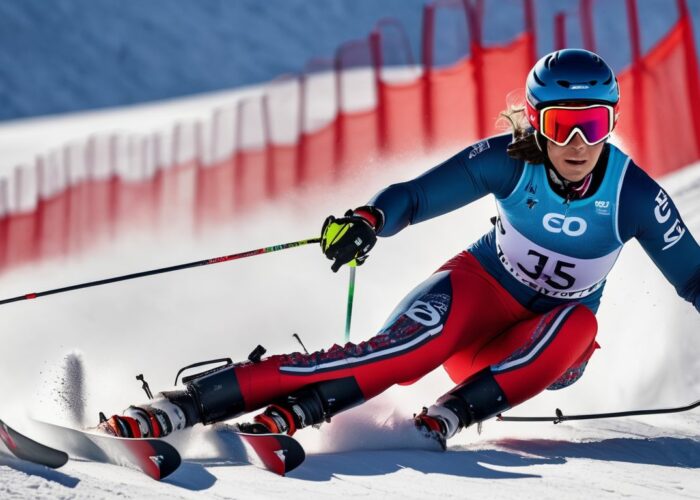Slalom skiing demands both precision and speed, a challenge that can stump even seasoned skiers. This dynamic discipline originates from the Norwegian term “slalåm,” weaving its meaning into every sharp turn and swift maneuver on the slopes.
Our article dives into techniques and tips to help you conquer those intimidating red and blue gates with confidence. Read on for the secrets to mastering slalom skiing’s artful dance between poles.
Key Takeaways
- Slalom skiing is a technical alpine sport that requires skiers to navigate through a series of gates with precision and speed; men’s courses typically feature 55 to 75 gates, while women’s have 40 to 60.
- Proper equipment, including shaped skis with radical sidecuts and protective gear like shin guards, is crucial for managing the tight turns and rapid maneuvers required by the slalom course.
- Arnold Lunn established the essential rules of slalom skiing in 1922, which included gate navigation and turn techniques that remain fundamental in today’s competitive landscape.
- Training and consistent practice are vital for improving slalom technique, involving exercises both on and off the slopes to develop quick reflexes, agility, balance, and muscle memory for executing precise movements at high speeds.
- The Winter Olympics along with world cup competitions serve as global platforms where elite skiers demonstrate their mastery of slalom skiing amidst intense international rivalry.
Understanding Slalom Skiing
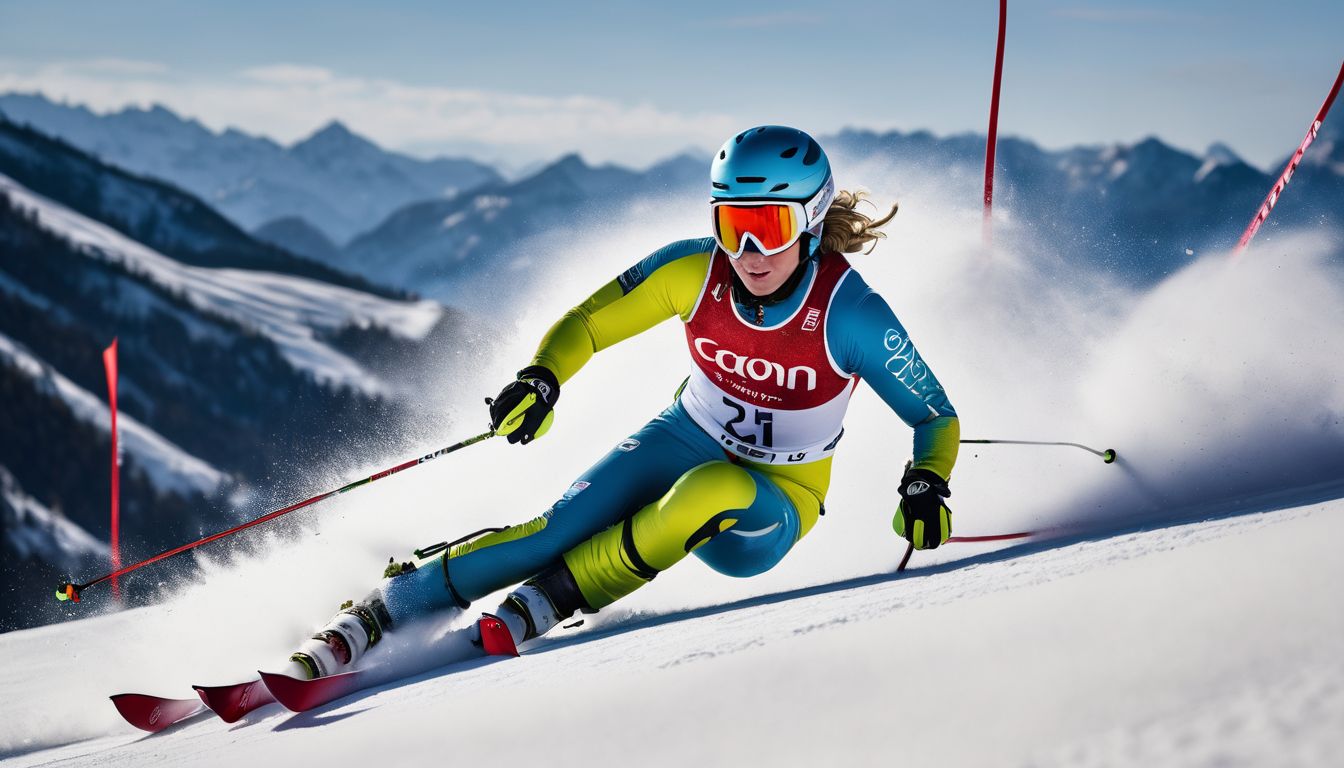
Slalom skiing stands as a pinnacle of technical alpine skiing, where racers hurtle down a snow-coated hill, weaving through a sequence of poles—or gates—at breakneck speed. Precision and agility are at the heart of this intense sport as competitors make sharp, rapid turns to clear each gate without missing or hitting them.
To succeed in slalom racing rules dictate that both ski tips and the skier’s boots must pass between the two poles that form each gate, demanding split-second timing and balance.
The stakes in slalom are heightened by FIS regulations which specify strict standards for equipment including the minimum length for competition skis. These detailed guidelines ensure not only fairness but also challenge athletes to excel within established parameters.
Slalom courses push racers’ limits with 55 to 75 gates for men’s events and 40 to 60 for women’s, marked by alternating red and blue poles designed to test skill levels across varied steepness—a vertical drop ranging from 180 to 220 meters ensuring thrilling competitions that keep both participants on their toes and spectators on the edge of their seats.
History of Slalom Skiing
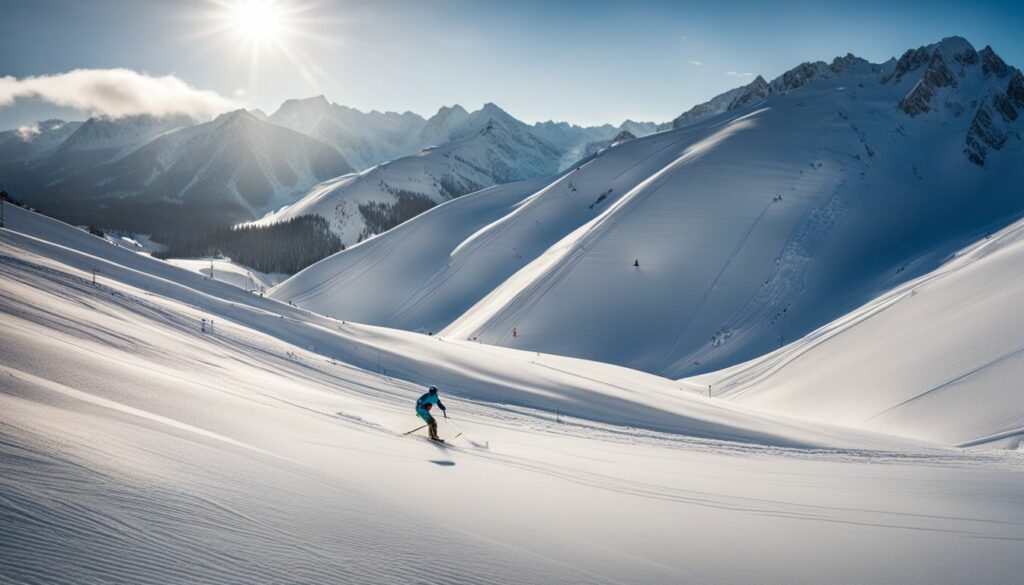
Arnold Lunn stands at the forefront of slalom skiing’s transformation into a competitive sport. In 1922, he set down the rules that would propel ski racing into the future during the British National Ski Championships.
His vision introduced gates and tight turns, which tested skiers’ agility and technique in ways that hadn’t been seen before. These rules were revolutionary for alpine skiing and established a new thrilling discipline.
As time progressed, so did slalom skiing, earning its place in the 1936 Winter Olympics and capturing the attention of audiences worldwide. The inclusion in such a prestigious event marked a significant milestone for slalom as it officially became an international competitive sport.
Athletes now train rigorously to master quick maneuvering through courses dotted with gates requiring lightning-fast reflexes—a true spectacle of skill and finesse on snow-covered mountainsides around the globe.
Check more List of Football Teams as per Club and Country – 2024 Updated
Mastering the Slalom Skiing Course
Mastering the slalom skiing course requires precision and agility, as skiers must navigate through a series of gates in a winding course with speed and control. To learn more about the essential techniques for mastering this challenging discipline, continue reading our blog.
Clearing the Gates
Slalom skiing demands precision and agility, particularly when it comes to clearing the gates. Skiers must navigate a downhill course dotted with a series of poles that challenge their control and speed.
- Each slalom gate is formed by two poles, either red or blue, through which skiers must guide themselves. The setup tests the athlete’s ability to make sharp, precise turns at high speeds.
- To successfully clear a gate, both ski tips and the skier’s boots must pass between the two poles. This rule requires tight maneuvering and encourages skiers to stay as close to the poles as possible without hitting them.
- Men’s slalom courses typically have 55 to 75 gates with a vertical drop ranging from 180 to 220 meters. Women tackle slightly fewer gates, between 40 and 60, with a correspondingly lesser vertical drop.
- Stance and body position are crucial; racers lean into turns maintaining balance while their bodies nearly touch the snow. Strong core muscles help maintain this challenging posture throughout the course.
- Quick reflexes enable a skier to adjust his or her path in an instant to avoid penalties for missing gates or hitting poles – mistakes that can cost valuable seconds.
- Racers use protective gear such as shin guards and pole guards not just for safety but also to gain aerodynamic advantages during these swift maneuvers.
- The technique for slalom skiing was standardized by Arnold Lunn in 1922. His pioneering rules still form the basis for today’s thrilling races seen in events like the Winter Olympics.
Check more 500+ Best Funny Volleyball Team Names that You Can Use in 2024
Essential Equipment for Slalom Skiing
Shaped skis have revolutionized slalom skiing, providing better control and maneuverability through the gates.
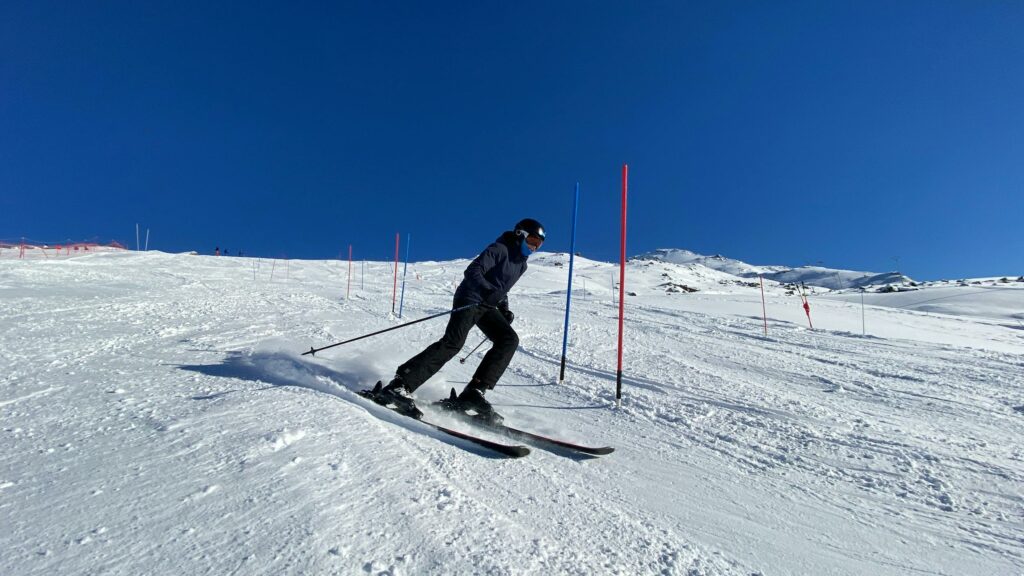
(Image Credit: Pexels)
| Equipment | Description |
|---|---|
| Shaped Skis | These skis have a wider tip and tail, allowing for quicker edge-to-edge transitions and improved carving ability. |
| Gates | The gates in slalom skiing are the markers that skiers must navigate between during the race. They consist of pairs of poles set at specific distances apart. |
| Ski Length Regulations | The International Ski Federation (FIS) sets minimum ski lengths for international slalom competition to ensure fairness and safety. |
| Radical Sidecut | This feature on shaped skis allows for sharper turns, crucial for navigating the tight corners of a slalom course. |
| Skiing Equipment Innovation | Technological advancements in ski design have played a significant role in improving racers’ performance in slalom competitions. |
Improving Your Slalom Skiing Technique
To improve your slalom skiing technique, you can follow these essential tips and techniques:
- Maintain a low and balanced stance while approaching each gate to ensure quick and precise turns.
- Practice proper weight distribution on your skis to maintain control and stability during sharp turns.
- Focus on carving smooth, efficient turns around the gates by engaging the edges of your skis effectively.
- Work on enhancing your agility and flexibility through targeted off-slope exercises to improve your performance on the course.
- Analyze video footage of your runs to identify areas for improvement in technique and timing.
- Seek guidance from experienced coaches or instructors to receive personalized feedback and guidance for honing your slalom skiing skills.
Check more 400+ Cool and Catchy Soccer Team Names That You Can Use Today – 2024 Updated
The Importance of Training and Practice
Mastering the slalom skiing technique demands precision, agility, and speed. Training and practice are crucial in honing these skills to navigate the course effectively. Skiers must consistently work on their short turns and maneuverability between gates to improve technique and timing.
Regular practice drills allow skiers to develop muscle memory for quick adjustments while navigating the challenging slalom course.
The importance of training becomes evident when skiers learn to anticipate gate placements and make split-second decisions regarding turn radius and edge control. Through dedicated practice sessions, skiers can enhance their ability to execute precise movements under high-speed conditions.
Moreover, consistent training instills confidence, enabling skiers to tackle the course with greater proficiency and composure during competitions.
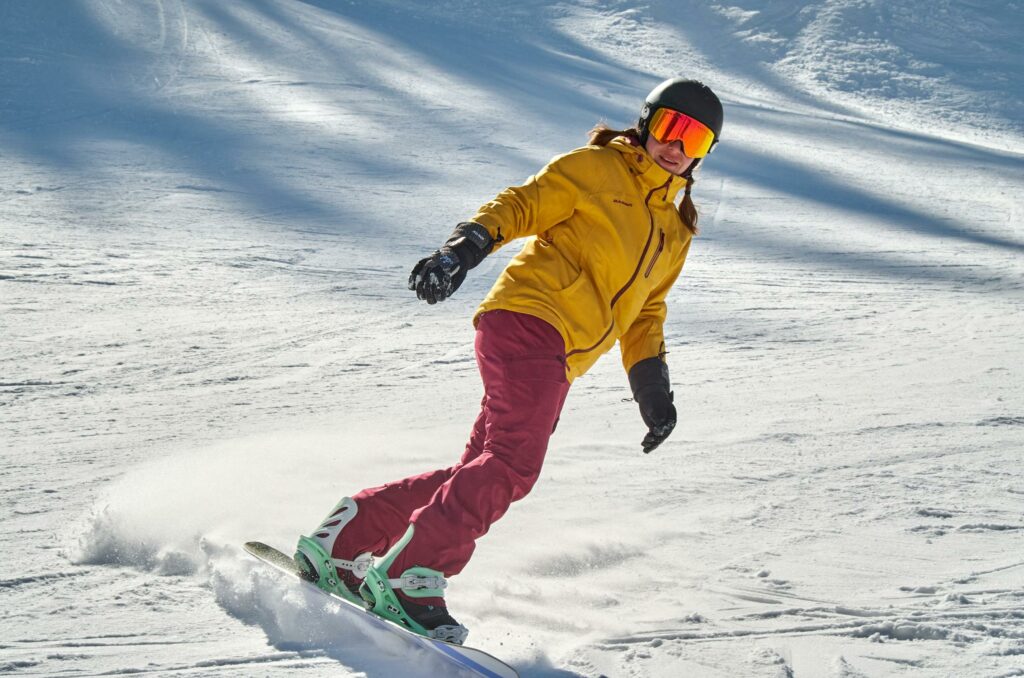
(Image Credit: Pexels)
Noteworthy Slalom Skiing Competitions
After honing your slalom skiing skills through consistent training and practice, it’s time to witness the pinnacle of this exhilarating sport at noteworthy slalom skiing competitions.
These events showcase the incredible speed, agility, and precision required to navigate the challenging course with skill and finesse. From renowned ski championships to the prestigious Winter Olympics, skiers from around the world compete for victory in their quest for alpine skiing glory.
The history of slalom skiing is rich with legendary athletes who have triumphed on these grand stages – from Jean-Claude Killy and Gustav Thöni to more recent champions. The men’s slalom World Cup has witnessed remarkable performances since its inaugural season in 1967, cementing its status as a thrilling display of athletic prowess.
As you continue refining your technique and embracing the thrill of slalom skiing, these competitions stand as inspirational milestones that epitomize excellence in alpine sports.
Conclusion
Mastering the slalom skiing technique demands precision and agility. Skiers navigate a winding course, clearing gates with quick, short turns. The sport’s evolution—from rigid bamboo poles to shaped skis—has revolutionized equipment and strategy.
Training and practice are key for refining reaction time and maneuverability. Noteworthy competitions showcase top athletes’ skills in mastering this exhilarating art form.
Frequently Asked Questions
How can I improve my slalom skiing technique?
Improving your slalom skiing technique requires practicing specific drills, focusing on body position and weight distribution, and seeking guidance from experienced skiers.
What equipment do I need to master the slalom skiing technique?
To master the slalom skiing technique, you will need appropriate water ski gear including a slalom ski designed for maneuverability, a secure-fitting life jacket, and a tow rope suitable for your skill level.
Can anyone learn the art of mastering the slalom skiing technique?
Yes, with dedication and proper instruction, anyone can learn to master the art of slalom skiing regardless of age or prior experience in water sports.
How do I build strength and balance to enhance my performance in slalom skiing?
To enhance performance in slalom skiing, focus on exercises that target core strength, leg muscles, and balance such as squats, lunges, planks, and stability ball exercises.
What are some common mistakes to avoid when learning the slalom ski technique?
Common mistakes include leaning back too much while crossing wakes which causes loss of control; using too much upper body rotation instead of engaging legs for turning; and not maintaining steady speed through turns leading to instability.


